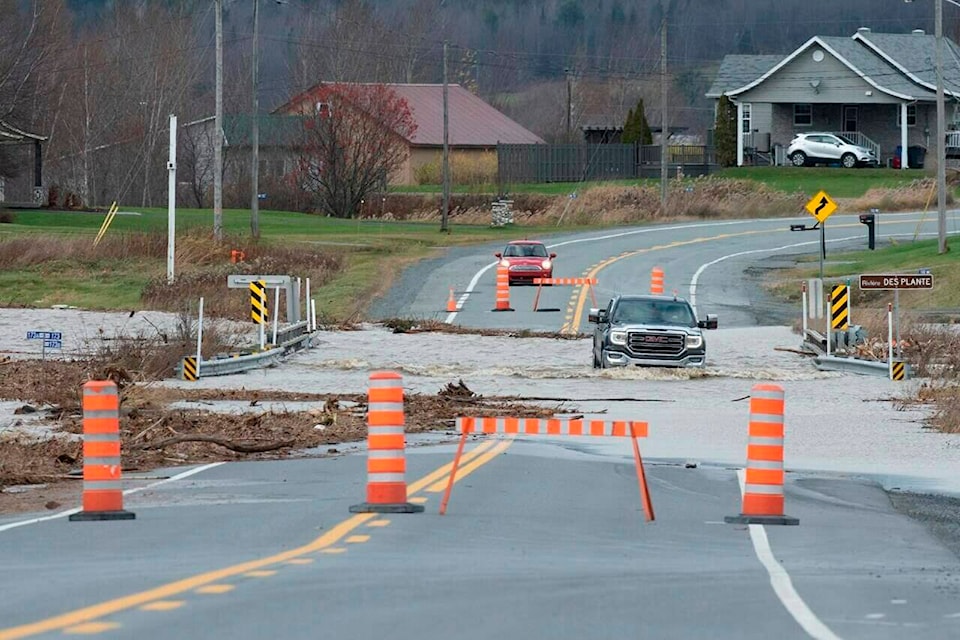Nearly five years after floods raced through hundreds of Quebec communities and forced thousands from their homes, a major lender’s decision to stop issuing new mortgages in flood zones is the latest challenge for cities trying to adapt to a changing climate.
Desjardins Group announced that as of Feb. 1, it would no longer offer new mortgages for properties in “0-20 year” flood zones — where there is a five per cent chance of flooding in any given year — because of what it called the rising impact of climate change.
There are some exceptions: buyers can get financing for up to 65 per cent a home’s selling price if the previous owner had a Desjardins mortgage and the property has protective measures to prevent flooding. But the company’s decision has left mayors of low-lying towns worried that homeowners will be left with properties that no one will buy or that are massively devalued.
Philippe Gachon, general director of a flood prevention research institute called RIISQ, says Desjardins’ decision is “just the beginning” of the challenges towns and cities will face as the province prepares to release new flood maps later this year.
“There are people who will discover that they’re in a risk zone when they didn’t necessarily know it before,” he said in a phone interview.
While the flood maps will be a good thing, they’re also a sensitive topic: they will determine who can get flood insurance, and who can’t.
‚ÄúThere will be other areas that won‚Äôt be insurable, or at prohibitive prices that are too expensive for most people,‚Äù said Gachon, who is also a hydroclimatology professor at Universit√© du Qu√©bec √Ý Montreal.
In an email, Desjardins cited the lack of flood insurance, government caps on flood compensation, and the rising cost of water damage as reasons to back away from flood-zone mortgages.
“It should be noted that properties in the 0—20-year zone are generally uninsurable … while government insurance protects a property for a maximum of $400,000 for life,” spokesperson Chantal Corbeil said in a recent email.
Traditionally, it has fallen on the Quebec government to step in to help homeowners cope with the costs of flooding. But after 2019, the government signalled its unwillingness to pay for repeated flood damage at the same address, imposing a new lifetime cap on compensation per home, and financial incentives for people to relocate from homes in high-risk zones.
According to the Insurance Bureau of Canada’s Quebec branch, the major flooding events of 2017 and 2019 cost insurers in Quebec $57,9 million and $279,7 respectively, in addition to the $390 million the province paid out for non-insured losses.
Some 340,000 properties, or 20 per cent of the population, are exposed to some degree of flooding, it said.
Jacques Demers, president of the federation of Quebec municipalities, said Desjardins was the last major lender to offer mortgages in higher-risk flood zones. Most banks, he added, don’t want to risk lending hundreds of thousands of dollars for a property that could become near-worthless after a flood.
“I’d probably do the same thing in their place,” he said, noting that the decision also protects families who could lose their investment.
Demers said the new flood maps will help municipalities make better decisions about where to build and about effective measures to protect existing buildings. He’s hopeful they might also reassure some insurers and lenders to re-enter certain areas once they realize they can be made safe.
Since the 2017 and 2019 floods, most municipalities no longer allow new buildings in areas at high-risk of flooding. However, Demers said some cities that have been hit hard by floods have taken varying approaches to adapt, with some exploring protective infrastructure, and others pressuring owners to move further away from the shore.
Beauceville, south of Quebec City, is one of the places that decided to move to higher ground, after an ice jam in 2019 on the Chaudière River burst free, sending water and chunks of ice through the heart of its historic downtown. Some 100 buildings had to be demolished after the worst flooding in 50 years.
Serge Vallée, the town’s general manager, said Beauceville is no stranger to flooding, and has always rebuilt by the river — largely because the sloping, watery and rocky terrain around downtown made it hard to expand. But after 2019, he said it was clear the town had no other option, noting that City Hall has been flooded four times and twice threatened by landslides or sinkholes.
And while some businesses remain in the flood zone — with new walls around them — the heart of downtown is relocating, he said.
But moving the town hasn’t been easy — especially since there aren’t many lots that are obvious candidates to build on. Looking for new space has included numerous studies, calls for funding from other levels of government, a series of delays and challenges related to COVID-19, rising interest rates, and the soaring costs of construction. But Vallée is also looking at the positive.
He said the town of just over 6,000 is using the opportunity to add more density by building four and five-storey buildings. The now-vacant waterfront where homes were demolished will also give citizens more river access, with public consultations being held to determine the site of future parks and amenities, Vallée added.
“We felt the disappointment that followed 2019, and the loss, especially of heritage buildings,” he said. “But today, the turnout at the public consultations is high, and we see people are ready for renewal.”
READ ALSO:
Morgan Lowrie, The Canadian Press



